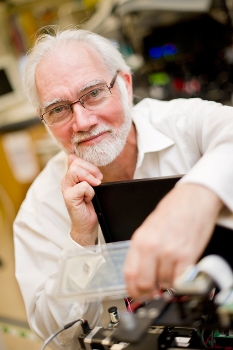May 9 2014
A research team using tunable luminescent nanocrystals as tags to advance medical and security imaging have successfully applied them to high-speed scanning technology and detected multiple viruses within minutes.
 J. Paul Robinson
J. Paul Robinson
The research, led by Macquarie University in Sydney, Australia and Purdue University, builds on the team's earlier success in developing a way to control the length of time light from a luminescent nanocrystal lingers, which introduced the dimension of time in addition to color and brightness in optical detection technology.
Detection based on the lifetime of the light from a nanocrystal as well as its specific color exponentially increases the possible combinations and unique tags that could be created for biomedical screens.
"We now are able to build a huge library of lifetime color-coded microspheres to perform multiple medical tasks or diagnoses at the same time," said Yiqing Lu, a researcher at Macquarie University, who led the research. "The time saved by omitting the need to grow or amplify a culture sample for testing and eliminating the need to run multiple tests will save future patients precious time so treatment can begin, which can be life-saving when managing aggressive diseases."
The technology could enable screens that identify thousands of different target molecules simultaneously, said J. Paul Robinson, the Professor of Cytomics in Purdue's College of Veterinary Medicine and professor in Purdue's Weldon School of Biomedical Engineering, who was involved in the research.
"This is the second part of the puzzle," said Robinson, who led the biological testing of the technology. "Now we've successfully measured the lifetimes of these tags on the fly at thousands of samples per second. The next step is to perform such high-throughput testing within a liquid, like water, blood or urine. That will open the door to widespread biological use and clinical applications, as well as the detection of pathogens in food or water."
Robinson's research focuses on flow cytometry, the analysis of cells that are contained in a liquid flowing past a laser beam. In addition to developing instrumentation to measure the tags, he plans to explore the technology's health care and biodetection applications.
The research team attached unique tags to DNA strands of HIV, Ebola virus, Hepatitis B virus and Human Papillomavirus 16. The tags were accurately read and distinguished at high speeds in suspension arrays. The team's work is detailed in a paper that will be published in the next issue of Nature Communications and is currently available online.